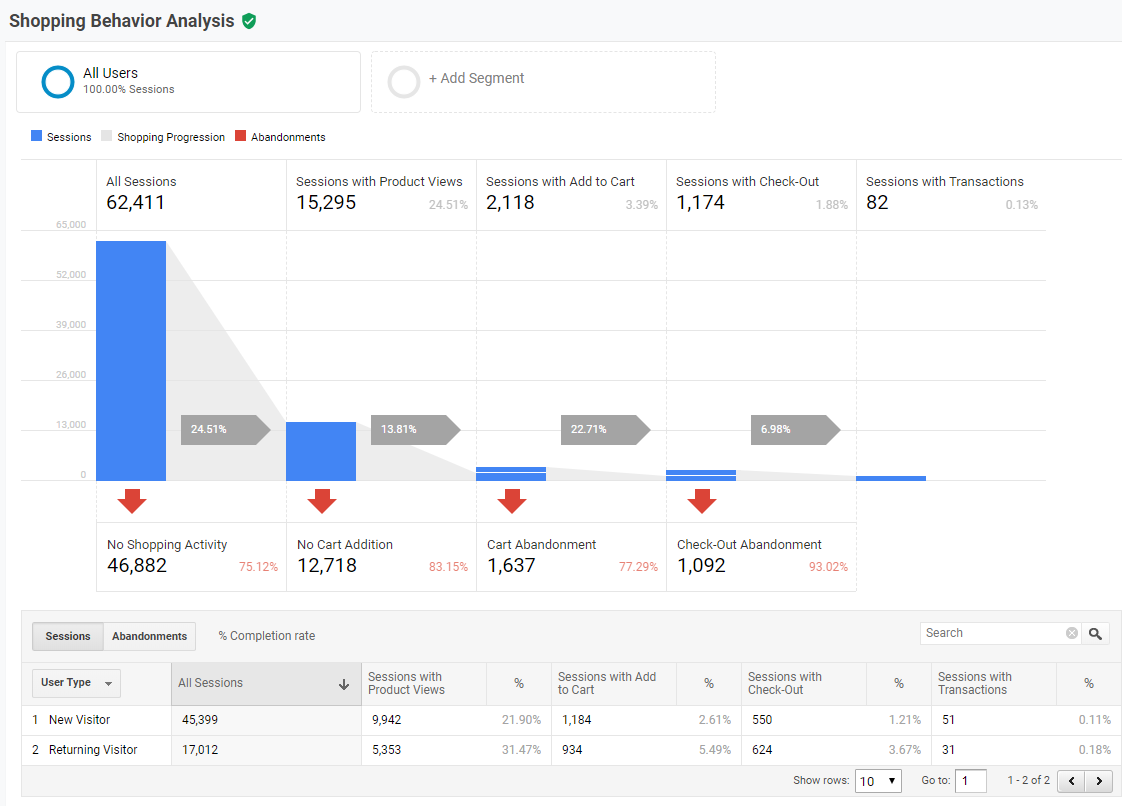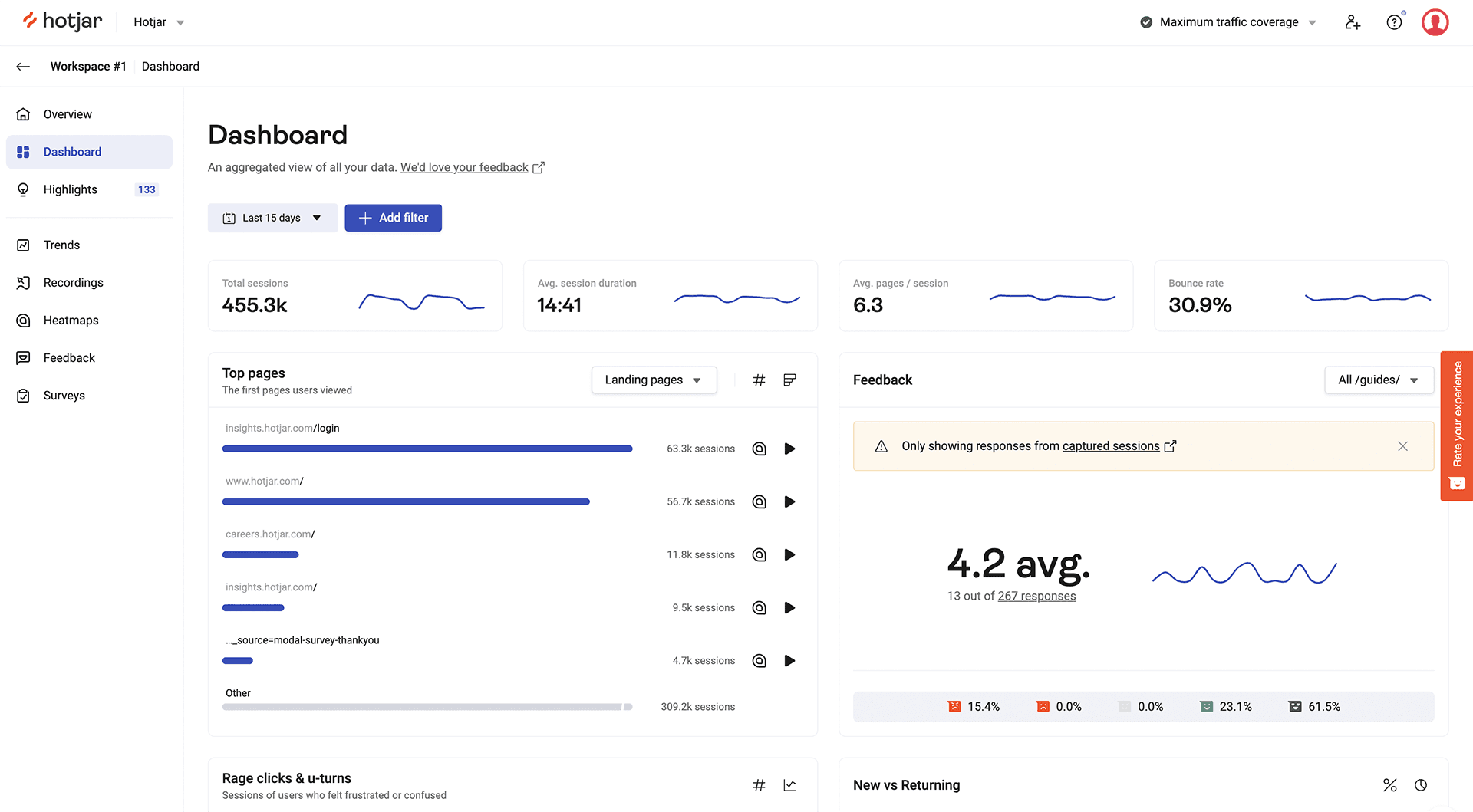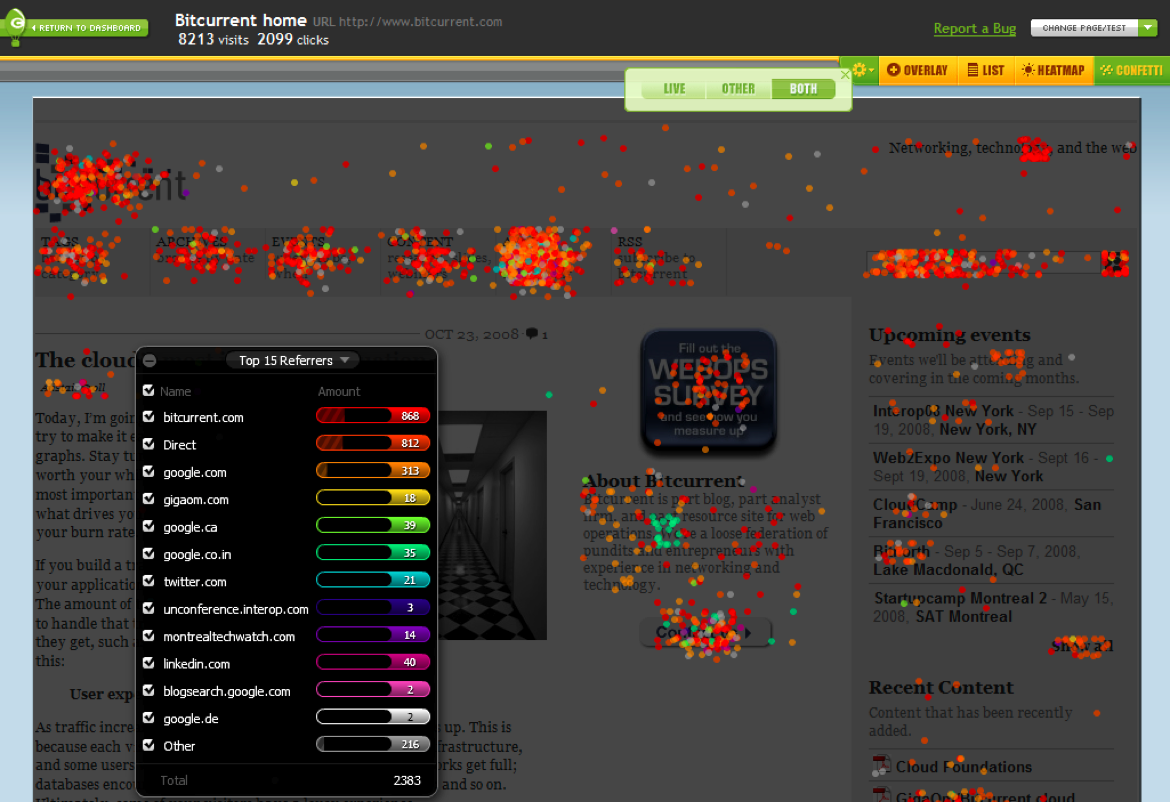The 5 Best eCommerce Analytics Tools In 2024
.png?width=1999&height=1333&name=image4%20(4).png)
In the fast-paced world of eCommerce, having access to the right data is the difference between simply surviving and thriving.
After all, how can you optimize your eCommerce business if you don’t understand your users’ behaviors, preferences, and interactions with your website?
The key to unlocking these insights lies in eCommerce analytics tools, which equip businesses with the information they need to:
- Understand their customer demographics.
- Track website traffic sources.
- Optimize their marketing campaigns.
- Target specific customer segments.
- Improve their conversion rate.
- Drive strategic decision-making.
With eCommerce sales projected to reach $8.1 trillion worldwide by 2026, it’s never been more important for businesses to have access to the right eCommerce analytics.
However, the sheer amount of eCommerce analytics software on the market can make choosing the right solution a challenge. In this article, we highlight some of the top analytics tools so you can find the one that’s best suited for your business.
What Are eCommerce Analytics Tools Used For?
eCommerce analytics tools help businesses dive deep into their customer behavior, sales data, and key performance indicators.
Armed with this knowledge, they can uncover insights that guide decisions across various departments.
Here's a closer look at why these tools are so important for any eCommerce store:
Analyze product performance
eCommerce analytics tools help companies identify best-selling and underperforming products.
This is essential for inventory management, adjustments to marketing campaigns, and financial planning.
Track customer behavior
Understanding how consumers interact with your eCommerce store is key to optimizing their shopping experience.
eCommerce analytics tools track user behavior to provide insights into their preferences and any roadblocks that might deter users from making a purchase.
Improve conversion rate
The ultimate goal of eCommerce analytics tools is to improve the customer experience and boost your conversion rate.
By analyzing the data from its analytics tools, an eCommerce business can make informed decisions, leading to enhanced customer satisfaction and increased conversions.
The Top eCommerce Analytics Tools in 2024
Among the countless options available, five analytics platforms set themselves apart from the rest.
Each offers unique capabilities tailored to different aspects of the customer journey, ensuring that any eCommerce business—regardless of its size or niche—can find the ideal analytics tool for its needs.
1. Google Analytics: Best free comprehensive tool

Google Analytics is a powerhouse that has become almost synonymous with eCommerce analytics.
As the go-to analytics tool for over 28 million websites, Google Analytics gives eCommerce businesses a comprehensive overview of:
- Their customer data.
- User interactions.
- The effectiveness of their marketing.
- Overall performance of their website.
Google Analytics enables marketers to unlock the stories behind their eCommerce data—why customers come to your site, what they do once they're there, and most importantly, what convinces them to either make a purchase or leave.
Key features
Google Analytics provides a comprehensive suite of features designed to help eCommerce business owners understand their audience and drive sales.
Here’s what makes it indispensable:
Traffic analysis: Easily track where your visitors are coming from and the volume of traffic. This helps you assess your online marketing efforts and ensure you’re getting a return on your investment.
Engagement insights: See which pages keep visitors engaged and identify those that are seeing higher bounce rates, so you know where improvements are needed.
eCommerce tracking: Monitor critical metrics such as conversion rates and lifetime value (LTV) to understand how your business is performing.
Product performance: Gain valuable insights into how individual products are performing on your site, which can inform both your marketing and inventory decisions.
Device source data: Understand whether visitors prefer desktop, mobile, or tablet, and tailor your site to accommodate these preferences.
Advanced eCommerce features: Use Google Analytics' enhanced capabilities to keep current customers and attract new ones by gaining a comprehensive understanding of their behavior on your site.
Drawbacks
While Google Analytics is often regarded as one of the best eCommerce analytics tools out there, there are a few areas where it falls short:
Data sampling issues: For sites with over 500,000 sessions, data accuracy may be compromised. This could affect the quality of insights that larger eCommerce operations get.
Learning curve: The platform's comprehensive nature can be challenging for new users, and it requires a time investment to navigate and use effectively.
Limited direct support: As a free tool, direct customer support is minimal, which might pose challenges for users who need help.
Pricing
Google Analytics 4 (GA4) is available for free, making it a great option for eCommerce businesses of any size.
2. Hotjar: Best for user-centric insights

Hotjar is a leading user behavior analytics platform that stands out for its intuitive tools. These are designed to provide eCommerce businesses with actionable insights into how customers interact with their websites.
Used on over 1 million websites across 180+ countries, Hotjar's approach to eCommerce analytics is innovative and user-centric, making it a valuable asset for online retailers aiming to optimize their sites and increase conversions.
Key features
Hotjar goes beyond traditional analytics by offering a suite of tools that allows eCommerce businesses to see their site through the eyes of their customers.
Here’s a breakdown of what Hotjar offers:
Heatmaps: Visualize customer engagement with click, move, and scroll maps to understand what attracts attention and what gets overlooked.
Recordings: Gain actionable insights from individual session recordings. You can use these to observe how visitors navigate your eCommerce store, then identify stumbling blocks and opportunities for improvement.
Surveys: Directly ask visitors about their experiences to learn why they convert or abandon their carts, providing invaluable feedback for enhancing the user journey.
Feedback: Implement a system to collect visitor feedback on key pages, assessing whether they meet user expectations and where refinements are needed.
User interviews: Conduct in-depth feedback sessions with actual or potential customers to dive deeper into their needs, preferences, and experiences on your site.
Drawbacks
Despite its powerful features, Hotjar has its limitations:
Data storage limits: Businesses with high-traffic websites might find Hotjar’s data storage limits restrictive, potentially limiting the depth of long-term insights.
Pricing: While Hotjar offers a free plan, higher-traffic sites may need to upgrade to more expensive plans to fully meet their needs.
Pricing
Hotjar’s pricing structure is designed to accommodate a range of businesses, from small startups to large enterprises:
Basic: Free, tracking up to 35 daily sessions with access to five analytics tools.
Plus: $32/month, designed for low to medium-traffic sites.
Business: $80/month, suitable for higher traffic sites requiring more extensive data.
Scale: Custom pricing for very high-traffic sites or those needing bespoke solutions.
3. Clicky: Best for real-time visitor insights
.png?width=1999&height=1080&name=image6%20(7).png)
Although Clicky is a lesser-known eCommerce analytics software solution, it’s a robust tool that offers a unique perspective on web analytics.
With its ability to provide detailed, real-time insights into visitor behavior, Clicky positions itself as a tool for eCommerce companies looking for granular analytics.
Where a platform like Google Analytics offers a broad overview of website performance, Clicky brings the action closer, allowing businesses to observe and analyze the digital footprint of each visitor with remarkable detail.
Key features
Clicky prides itself on a range of features that cater to the nuanced needs of eCommerce businesses, focusing on real-time data and user-specific insights:
Detailed visitor insights: Track individual visitors, including their location, operating system, browser, and navigate their click path around the site in real-time.
Real-time analytics: Monitor your site’s activity as it happens with the Spy feature. This allows you to see user movements from page to page, coupled with audible alerts for new visits or actions.
Multi-site dashboard: Manage and monitor multiple websites within one dashboard, streamlining the tracking and analysis processes for businesses with a big online presence.
User-friendly interface: Clicky is known for its intuitive interface that simplifies navigation and data interpretation, making it accessible for professionals with all levels of experience.
Drawbacks
Despite its strengths, Clicky has some limitations that businesses should consider:
Pricing: Clicky's pricing is higher than other similar analytics platforms, especially when scaling up features and tracking requirements.
Limited integrations: The platform’s integration options with other marketing and analytics tools are limited, posing challenges for businesses that rely on a broader ecosystem of tools.
Customization: There is a lack of customization options within Clicky, which can make it challenging to tailor the platform to individual eCommerce business’s needs.
Pricing
Clicky offers a versatile pricing structure, including a free trial and several paid tiers:
Free 30-day trial: Experience Clicky’s Pro account features, including heat maps and goal tracking.
Basic (Free): You can continue with a free account after the trial, albeit with reduced functionality.
Pro: $9.99 per month or $79.99 per year for up to 10 websites and 30,000 daily page views.
Pro Plus: $14.99 per month or $119.99 per year, with heat maps and uptime monitoring included.
Pro Platinum: $19.99 per month or $159.99 per year for up to 100,000 daily page views. This tier includes all Pro Plus features.
Custom Package: Tailored to those tracking more than 50 domains or exceeding 100,000 daily page views.
4. Contentsquare: Best for in-depth customer journey analysis
.png?width=1999&height=1245&name=image1%20(9).png)
Contentsquare, previously known as ClickTale, has evolved into a comprehensive tool for digital experience analytics.
The transition from ClickTale to Contentsquare has broadened the platform's capabilities, making it a more holistic tool for eCommerce sites by focusing on optimizing the digital customer journey.
It now offers businesses a wide array of analytics tools designed to uncover hidden customer behaviors and use those insights to drive more successful experiences.
Key features
Contentsquare distinguishes itself with features that provide an almost ground-level view of customer interaction on your site:
Session recordings: See your users’ digital journeys through recorded playback that shows every mouse move, click, page scroll, and form fill. This feature offers insights into the customer experience and allows businesses to pinpoint areas of friction.
Heatmaps: See where users click, move, and scroll with a graphical representation of user engagement across your site.
Digital experience analytics: Beyond traditional analytics, Contentsquare dives into the nuances of customer behavior with tools like journey analysis and zoning analysis to provide a comprehensive understanding of how users interact with your site.
A/B testing integration: Combine the qualitative data from Contentsquare with quantitative data from A/B testing to implement data-driven design changes.
Drawbacks
While Contentsquare is a powerful analytics tool, there are some considerations to keep in mind:
Pricing: The platform may be prohibitively expensive for small to medium-sized businesses.
Complexity: The depth of data and analytics available can be overwhelming for new users, and requires a steep learning curve to fully take advantage of the platform's capabilities.
Pricing
Contentsquare tailors their pricing to each business, and pricing information is not available online. However, users have noted these price ranges:
Small to medium businesses: For companies with a headcount of around 200, Contentsquare's annual pricing ranges from $24,000 to $41,300.
Larger enterprises: Companies with a headcount of 1,000 can expect annual costs to range from $43,300 to $74,400.
5. Crazy Egg: Best for heatmap and session recording integration

Crazy Egg is a powerful heatmap and session recording tool designed to help eCommerce businesses gain insights into how users interact with their websites.
With its ability to visualize user behavior through clicks, scrolls, and engagement, Crazy Egg helps you uncover the effectiveness of your site design, layout, and content.
Key features
Heatmap view: Displays a color-coded data visualization of clicks on your eCommerce site, identifying areas of high and low engagement.
Scrollmap view: Shows how far users scroll down your pages, helping to pinpoint where users lose interest or where key content might be missed.
Google Analytics integration: Crazy Egg's integration with Google Analytics enables businesses to merge heatmaps and session recordings with Google’s quantitative data for a complete view of behavior on their site.
Ease of use: It features a straightforward setup process, with a simple interface and a WordPress plugin for easy integration.
Drawbacks
Support: Users have reported that the support can sometimes be generic and slow, identifying a need for a more efficient real-time support system.
Reporting and data export: There's room for improvement in how data is reported and exported so users can create more comprehensive custom reports.
Integration with A/B testing tools: Direct integration with A/B testing tools, which streamline the process of validating design changes, is not a built-in feature.
Pricing
Crazy Egg offers competitive pricing with a free trial and several paid tiers:
Free 30-day trial: You can try any of the below plans for free for 30 days.
Standard: $49.99 per month for unlimited surveys, websites, and A/B tests.
Plus: $99.99 per month. It includes everything in Standard, plus priority support, more snapshots for visual data analysis, and up to 1,000 user session recordings per month.
Enterprise: $249 per month. It includes everything in the Plus tier, along with the ability to track up to 500,000 page views per month and up to 5,000 user session recordings per month.
Key Considerations When Choosing an eCommerce Analytics Tool
When exploring the various eCommerce analytics tools available, there are several factors to consider to ensure you select the best solution for your online business:
Integration with eCommerce platforms
Your analytics software should easily integrate with your existing eCommerce platform.
This ensures that data management across systems is efficient and you have a full overview of your eCommerce data without the hassle of manual transfers.
Customer behavior tracking
Your eCommerce analytics tool should offer detailed insights into customer behavior, including how users interact with your site, their buying patterns, and their journey through the sales funnel.
Real-time analytics data
In the fast-paced eCommerce environment, having access to real-time data allows you to make fast decisions that can positively impact your business performance and customer engagement strategies.
Sales performance analysis
Your eCommerce analytics tool should track sales data and provide insights into sales performance across different marketing channels.
This includes the ability to analyze the effectiveness of Google Ads campaigns and the performance of products on platforms like Shopify.
Customer feedback
The ability to collect feedback directly through your analytics platform gives you actionable customer-focused data to use.
This helps you enhance the customer experience and ultimately, boost your conversion rate.
Streamline Your eCommerce Store with Spark Shipping
In eCommerce, efficiency and automation are key to staying ahead. That's where Spark Shipping comes in, offering seamless integration with your chosen eCommerce analytics platform.
We automate core processes across your sales channels, simplifying tasks such as uploading products, managing inventory, and processing orders.
Whether you're selling on Amazon, BigCommerce, Shopify, or any other platform, we ensure that your inventory is synchronized in real-time with those of your vendors so you’re always ready to fulfill orders.
With Spark Shipping, you can enjoy:
Automated inventory updates: Never worry about overselling or stock discrepancies again. Spark Shipping updates your inventory across all channels in real-time.
Pricing automation: Keep your pricing competitive and in compliance with vendor requirements, all updated automatically.
Vendor integration: Spark Shipping connects you with a wide variety of vendors, making it easy to manage your products, regardless of where you sell or who you buy from.
Are you ready to take your eCommerce business to the next level? Automate your operations, enhance efficiency, and boost your sales with Spark Shipping. Request a free demo today.
Popular Posts
Posts by Topic
- Dropshipping (5)
- Dropship Suppliers (3)
- EDI (3)
- Amazon Seller Central (2)
- Conversion Rate Optimization (2)
- Dropshipping Products (2)
- Order Management (2)
- Pricing Strategy (2)
- Vendor Product Catalog (2)
- Dean Soto (1)
- Dropshipping Automation (1)
- Feature Announcement (1)
- Online Empire Academy (1)
- Product Optimization (1)
- Shipping (1)
- referral marketing (1)